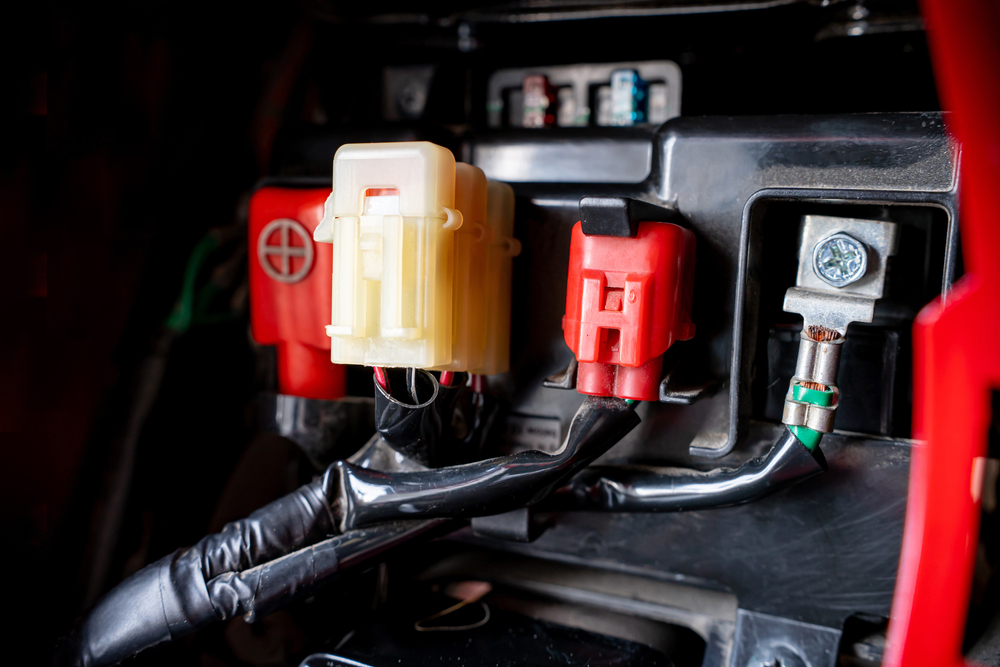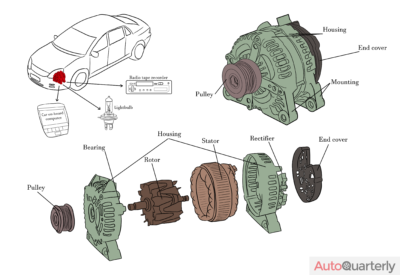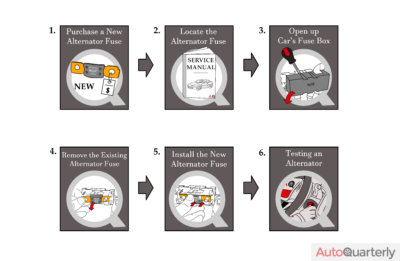Alternators charge your vehicle’s battery when the engine is running, and they’re responsible for starting your car. Alternators are durable components that last for well over 100,000 miles, but sometimes the fuse can fail. Blown alternator fuses result in a dead battery, dim headlights, dashboard warning lights, and other electrical problems.
Failing to replace a blown alternator fuse leads to additional problems, like damage to the alternator and other electrical systems. Always have a trained professional inspect your alternator or electrical systems for other problems because alternator fuses don’t randomly blow.
That said, replacing an alternator fuse isn’t expensive and can be done by anyone. In fact, you don’t usually need tools to pop the fuse box open. Expect to pay around $20 for the part, and $50 to $100 for labor at a professional automotive shop.
What Alternators Do and How They Work
The alternator’s primary purpose is to convert mechanical energy into electrical energy. It accomplishes this by using magnetic induction, and it functions as a charger for the car battery when the engine is running.
Without an alternator, car batteries wouldn’t hold their charge for as long, because power for accessories (headlights, lights, HVAC) has to come from the battery instead. For these reasons, you can compare an alternator to a generator, and people even used to call the alternator a generator.
What Are the Signs of Alternator Failure?
Several signs suggest that your alternator is worn out and needs to be replaced. Typically, you’ll begin to notice electrical problems before the more serious issues come later. Below, we list several problems that suggest it’s time for a new alternator:
- Battery warning light
- Problems with electrical systems and blown fuses
- Loud noises coming from the engine bay
- The car struggles to start or won’t start
- Problems with belts
- HVAC system issues
Because many signs point to an alternator failure, it’s necessary to get your vehicle diagnosed properly by a professional.
Can an Alternator Destroy a Battery?
Alternators won’t directly destroy a battery, but if it’s not functioning, the battery has to work harder. When the battery is working harder, it loses voltage quickly, which can result in premature failure. So, indirectly alternator failure will lead to battery failure if the problem doesn’t get addressed.
All You Need to Know About the Alternator Fuse
Alternator fuses, or alternator fusible links, are located within your vehicle’s fuse box, which houses fuses for most electrical components. The fuse box is important because it controls the amount of electricity that flows through components.
When fuses fail, it cuts off the flow of power to prevent fires and other problems. Therefore, you can think of a fuse as a type of failsafe for safe alternator operation.
Learn more about alternator fuses below.
Where Is the Alternator Fuse Located
Alternator fuses are located in your vehicle’s fuse box, so you won’t find the source of the problem on the alternator. The location of the fuse box varies, but it’s usually on the left side of the engine if you’re looking into the engine bay.
Within the fuse box, you’ll find a handful of fuses and the alternator fuse. To find the specific location of the fuse in the fuse box, check your vehicle’s owner’s manual.
Blown Alternator Fuse Symptoms
A blown alternator is simple to diagnose when you know what to look for. The most common symptoms you’ll face include faulty electronics and accessories. This includes dim headlights, a dead battery, and issues with interior accessories while the engine is running. You’ll experience these symptoms because the alternator will no longer function without the fuse.
Other signs of a bad alternator fuse include some visual problems. For example, if you open the fuse box and see a melted fuse, you know what the problem is.
What Happens When an Alternator Fuse Blows?
When an alternator fuse blows, the alternator will no longer function properly. This is because the electrical current won’t flow through the fuse and reach the alternator or other components.
Therefore, the alternator will fail, and the battery will fail if you continue to drive the vehicle. So, a bad alternator fuse will drain the battery over time by forcing the battery to do more work.
You may also smell smoke coming from the engine bay if the fuse melts.
What Causes an Alternator to Blow?
Alternators will blow for a few reasons. The most common problem is that there is an excessive current flowing through the fuse. Too much energy will result in a blown fuse. A blown fuse will look melted and damaged because of the amount of heat that flowed through it.
You can tell that a fuse is blown by examining how the fuse looks. A blown fuse will have some or all of these attributes:
- Melted metal on the ends of the fuse
- The link inside the plastic cover is no longer connected
- You find gaps in the wiring
- Glass fuses will appear dark or thicker when blown
- The wires inside the fuse are damaged
You can check if a fuse is blown by looking for these indicators.
How Much Does an Alternator Fuse Replacement Cost?
Alternator fuse replacements don’t cost too much, because the part is only $20. However, if you need to replace the entire fuse box, the cost can climb up to $125 or $140. The price varies based on your vehicle and the rate of the shop replacing the fuse.
The good news is that most alternator replacement jobs are easy, and you can do them on your own.
How to Check an Alternator Fuse
There are a few quick steps you can follow that will help you check an alternator fuse. First and foremost, view your vehicle’s dashboard and look for the illumined alternator symbol. If you see a symbol that has a battery with “Alt” or “Gen” next to it, that’s the alternator symbol (it may also be a “+” or “-,” depending on your vehicle).
Once you see this light illuminated, follow the steps below to check the alternator fuse.
- Open the hood of your vehicle and disconnect the battery.
- Locate the fuse box. Fuse boxes are usually small, black rectangular boxes.
- Pop open the fuse box and locate the alternator fuse. To find the fuse, reference your owner’s manual for the right fuse locations (typically, it’s numbered).
- Remove the alternator fuse.
- Check the alternator fuse for melted components like plastic, metal, or wires.
Following these steps can help you diagnose and replace an alternator fuse.
Fusible link
Fusible links give your vehicle an additional layer of precision. A fusible link is a short section of wire that’s smaller than other wires within the current. The smaller diameter helps the wire act as a high-current fuse that prevents circuits from drawing too much power which can result in melting.
Fusible links are located in areas of the vehicle where a large amount of electricity passes through the current, which is why there is a fusible link between the battery and alternator in most vehicles.
Fusible Link Between the Alternator and Battery
The fusible link for the alternator in most vehicles is between the alternator and the battery. It’s placed in this location to prevent large currents from cashing sparks, fires, or damage to other components. Most fusible links have to be strong enough to carry the full load of the alternator while leaving room for another 10%.
It’s also worth noting that most alternator fusible links have to be two gauges smaller than the harness that they’re connected to.
What Does a Bad Fusible Link Look Like?
When a fusible link goes bad, the biggest indicator is its appearance. If you notice that the link looks melted or charred, it’s time to replace it. Bad fusible links may be disconnected from the circuit and dangling if the situation is bad enough.
You’ll likely notice a few symptoms before the link fully melts or gets charged.
Symptoms of a Bad Fusible Link
Fusible links have a few symptoms that you’ll notice. The early signs of a bad fusible link include issues with components like power windows and interior accessories. This is because not enough power is reaching these accessories as the link becomes severed.
As the problem gets worse, you may smell something burning from the engine bay. The alternator and battery may also fail if you don’t address the problem. Thankfully, fusible connections are affordable and cost about as much as a fuse.
Battery Fuse
The battery fuse is the most important fuse that your vehicle has. It’s the first line of defense against electrical problems and will melt if there is a risk of too much power getting to things like your radio.
Battery fuses are connected to the battery and look like other fuses in your vehicle. You can tell when a battery fuse is blown by checking the metal wire inside the fuse. If it’s severed or anything looks melted, there’s a chance that the fuse is bad.
What Are the Symptoms of a Blown Battery Fuse?
A blown battery fuse may have a few symptoms. Depending on the extent of the damage, a blown battery fuse will have these symptoms:
- The engine won’t crank
- Headlights, interior lights, and other lights won’t work properly
- Central lock and power windows fail
- Lights might flicker or an indicator light will come on
- Power might not reach the starter relay, which is necessary to keep your car moving
- Burning smells
Noticing any of these symptoms likely means that your battery fuse is bad.
How to Fix an Alternator With a Blown Fuse
Replacing a blown fuse is not the toughest auto repair job in the world. What does make it a little complicated is the fact that most car fuse boxes these days have dozens of fuses. This is the only real complicating factor in the process. We’ll cover how you can find out where the alternator’s fuse is specifically. Let’s take a look at what the process looks like step by step.
Purchase a New Alternator Fuse
This is the obvious first step in the process and it’s quite easy. All you need to do is head down to your local auto parts store and name the make and model of your car. They’ll hand over its fuse to you with just that information. Alternatively, you can also purchase the fuse online if you know the one that needs to go in your car.
Locate the Alternator Fuse
This is the step in which you want to pay a little extra attention. As mentioned earlier, fuse boxes in cars these days are chock full of many different fuses–sometimes as many as 40 different kinds. So when you set about changing the fuse for your alternator, you want to make sure you’re working with the right one.

The best way to do that is by taking a look at your car’s owner’s manual. Yes, you need to dust the old thing off so you can find out where the alternator’s fuse sits. The instruction manual will usually have a diagram which shows the layout of the fuse box and where each specific fuse goes. Simply look at the part that’s marked for the alternator fuse since that’s the one we need to find in the next step.
Open up Your Car’s Fuse Box
Now finding your car’s fuse box itself isn’t as obvious as it sounds. That’s because different manufacturers put this part in different locations. In some cases it may be under the hood; in others you may find it under the steering wheel or seat. Once again, check the owner’s manual to find out.
Once you’ve located the fuse box, it’s time to open it up. You should be able to take the cover off using just your fingers in most cases. But you should have a screwdriver handy in case it takes some extra effort to pop off the top of the fuse box. But make sure to do it gently so that you don’t damage the fuse box’s cover in any way.
Remove the Existing Alternator Fuse
At this point you will be met with a fuse box full of several different kinds of fuses. You will be able to locate the alternator’s fuse since we’ve already looked for it in the owner’s manual.
Much like the cover of the fuse box, you should be able to extricate the alternator’s fuse from the fuse box using just your fingers. Bur once again, you could use a screwdriver if the fuse is sitting in its position too snugly. Just make sure to get the fuse out without causing any damage to the rest of the fuse box.
Install the New Alternator Fuse
There’s one final check you need to make before you can install the new alternator fuse. Take a look at the fuse rating on your old alternator and on the new one. They should match. If they don’t, then you need to go back and find an alternator fuse that has a matching rating.
If the fuse ratings match, then you can proceed with the installation. All you need to do is push the new fuse down into its position and make sure that it sits there snugly. You can then get the cover on your fuse box back on and that completes the process of replacing an alternator’s fuse.
Testing an Alternator
Once you’ve installed the alternator, it’s time to test whether the setup works. If you’re doing this at home, then the only way to test the alternator is indirectly. That is, you will have to start your car and turn on some of the electrical equipment in it. If the car starts easily and all the electrical equipment works fine, then you’ve carried out the installation correctly.
Mechanics have the ability to test alternators in a more direct fashion. They do that using a charging system tester. This will let them know if something is wrong with the charging system and if the alternator is at the root of it. A charging system test costs about $50.
You don’t, however, need to take your car down to the shop if you have an alternator with a blown fuse. As we’ve seen, the process of replacing the fuse isn’t too complicated. But if you don’t feel equipped to do it, then you can have a mechanic replace the part for you.
Telling Alternator Problems From Battery Problems
Alternators and batteries play similar roles in cars. So it can be hard to tell whether you have an alternator with a blown fuse or an issue with your battery. Thankfully, there’s a simple way to tell the two apart.
Start by jump-starting your car. Now remove the jumper cables. If the issue is with the battery, then the car will continue to run at this point. This tells you that your battery probably needs to be charged. If your car dies when the cables come off, then that’s a sign that the alternator isn’t doing its job.
Final Thoughts
When you know that you’re dealing with a blown alternator fuse, you can get back on the road fast. Plus, you can save yourself a trip to the mechanic. Alternator fuses are inexpensive and easy to replace, so it’s a great idea to do the job yourself. What’s more, you’ll learn something about your vehicle that you can take with you for other repairs.
That said, fuses usually blow for a specific reason, so it’s never a bad idea to have your vehicle looked at by a professional.





Before going to the store to buy a new fuse, can you do a continuity test to see if the fuse is still working?